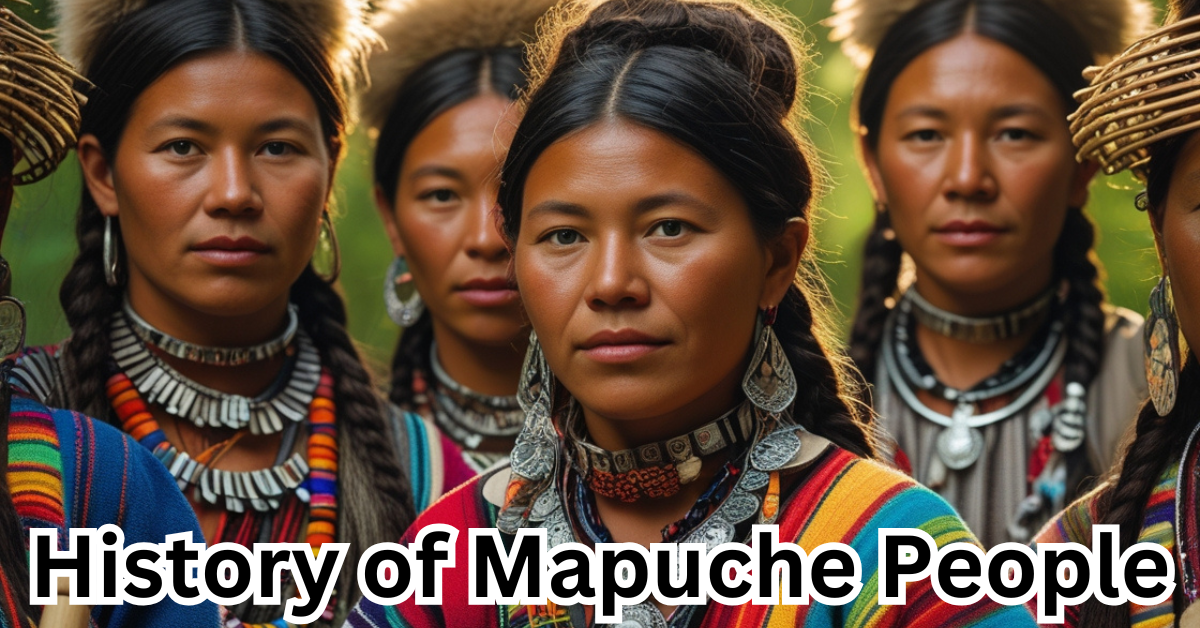Mapuche People
The Mapuche are the largest Indigenous group in South America, with a population of over 1.4 million at the turn of the 21st century. Primarily located in the Central Valley of Chile, south of the Biobío River, a smaller group also resides in Neuquén province, Argentina.
Each settlement had a cacique (chief), whose authority typically did not extend beyond his village. The Mapuche cultivated crops like corn, beans, squash, potatoes, and chili peppers, and supplemented their diet with fish, hunting, and the keeping of guinea pigs for meat. Llamas were kept for wool and as pack animals, and a man’s wealth was often measured by the size of his llama herd.
The Mapuche are especially known for their 350-year struggle against Spanish and later Chilean domination. Their resistance during the 16th, 17th, and 18th centuries was remarkable. To counter Spanish forces, the Mapuche reorganized their way of life, forming military, political, and economic alliances between villages. Mapuche warriors, adapting to new tactics, became skilled horsemen, and leaders like Lautaro emerged as formidable military strategists.
After Chile gained independence from Spain in the 19th century, the Mapuche were forced onto reservations. For more than a century, they farmed collectively on these lands. In the 1980s, the Chilean government transferred land ownership to individual Mapuche, a move that often led them into debt. Because the Mapuche practiced a less intensive form of agriculture, many found themselves struggling to repay debts, risking the loss of their land and livelihood.
History of Chile
Chile, located along the western coast of South America, stretches 2,700 miles (4,300 km) from its border with Peru to the tip of the continent at Cape Horn. It is bordered by Peru and Bolivia to the north, Argentina to the east, and the Pacific Ocean to the west. While Chile shares the typical characteristics of Latin American countries, it has been unique in maintaining representative democratic government for most of its history, aside from a military junta that ruled from 1973 to 1990.
Precolonial Period in Chile
When the Spanish arrived in the mid-16th century, around 500,000 Indigenous people lived in the region, spread across various tribal groups. Though these groups shared a common language, they lacked centralized governance. The northern tribes, influenced by civilizations from Peru, practiced fishing and farming in oases, while the Araucanian peoples in the south led more mobile lives, with a mix of hunting, gathering, fishing, and trading. Despite the Spanish invasion and attempts by the Inca Empire, the Araucanians fiercely resisted foreign domination.
Spanish Conquest
The Spanish conquest of Chile began in 1536 when Diego de Almagro, after a failed attempt to find riches, returned to Peru. It was not until 1540 that Pedro de Valdivia, granted authority by Francisco Pizarro, led a second attempt to colonize Chile, founding Santiago in 1541. The Spanish faced constant resistance from the Indigenous tribes, particularly the Araucanians, who strongly opposed enslavement.
After the death of Valdivia in 1553, the Araucanians, led by the military strategist Lautaro, continued to resist the Spanish, initiating a prolonged conflict that lasted well into the 19th century. Despite destruction of settlements like Concepción, the Spanish maintained a foothold in northern and central Chile, while the Araucanians adapted their tactics to successfully fight off colonial forces.
Colonial Period
Chile’s economy was largely based on agriculture rather than mining, as precious metals were scarce. The settlers grew cereals, vegetables, and raised livestock, with a small African slave population. The Spanish crown and the Catholic Church played central roles in the colony, with the church monopolizing education and other aspects of daily life. By the end of the colonial period, Chile’s population had grown to around 500,000, with mestizos (mixed Indigenous and European descent) making up the majority.
The 18th century saw a slow development in Chilean intellectual life, and the colony faced economic difficulties, being largely dependent on subsidies from Spain. The social structure was rigid, with Spanish-born peninsulares at the top, followed by Creoles, mestizos, Indigenous peoples, and enslaved Africans.
Chile’s isolation from the broader Spanish Empire, along with limited trade, reinforced a sense of insularity. Despite this, the colony laid the groundwork for a burgeoning sense of Chilean identity, which would eventually culminate in independence from Spain in the early 19th century.
Struggle for Chilean Independence
In the early 19th century, Chile’s isolation began to change as global events influenced its path toward independence. Key developments such as the independence of the 13 American colonies, the Haitian Revolution, and the French Revolution, coupled with Spain’s weakening hold on its empire, set the stage for change. British incursions into the La Plata region and increased contraband trade also signaled Spain’s inability to maintain control. The final spark came in 1808, when Napoleon’s intervention in Spain left the Spanish colonies to fend for themselves, prompting the first steps toward Chilean autonomy.
On September 18, 1810, a pivotal town meeting in Santiago led to the resignation of the Spanish president-governor and the election of a local junta. From 1810 to 1813, Chile maintained a relatively peaceful path towards self-governance, easing trade restrictions, advancing the abolition of slavery, and fostering education. However, internal conflicts arose, particularly between the Creoles who debated the extent of independence. José Miguel Carrera and his brothers pushed for total independence, often driven by personal ambition, while Spain attempted to reassert control. The Battle of Rancagua on October 1-2, 1814, ended Chile’s first independence efforts, marking the end of what is known as “la patria vieja” or “the old fatherland.”
